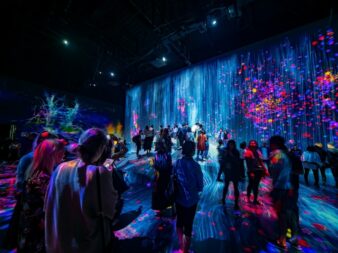Today’s travelers are looking for cultural experiences that are personal and feel tailored to their own interests. Your museum or tourist attraction can feel that way — you just need to get innovative with your marketing. Use these creative marketing ideas for museums and attractions to reach modern culture vultures.

1. Be a disruptor

Starting from 2018, Amsterdam’s Tropenmusem made the conscious effort to decolonize their exhibition spaces. In a sea of museums that embrace the traditionalist view of the Dutch Golden Age, the Tropenmuseum stands out.
This is just one example of museums embracing a culture of disruption and using it as a museum marketing campaign. Whether it’s changing the tone you use to speak about cultural offerings or shaking up the values of conventional tourism, these actions draw attention.
Dan Burdett, Tiqets CMO
“Disruptors have one thing in common – a simple formula: they offered more of what their customers wanted and less of what they did not.”

2. Reconsider standard opening hours

Even the biggest museums in the world constrict themselves to conventional opening hours. While more established museums don’t suffer from a lack of visitors, smaller institutions and attractions may be missing out on a large part of the community.
Daytime hours see attendance from families and groups of schoolchildren. This can be overwhelming to adults without kids, university students with free time to burn, the 9-to-5 desk-bound worker, and young professionals who are are increasingly embracing remote working culture.
Opening when it’s convenient for a wider audience to visit may sound like a no-brainer, but it’s a tough process to follow through. However, it can be an effective marketing tool for smaller museums
Moco in Amsterdam keeps its doors open until 7 pm each evening, and 8 pm on Saturdays. Visitors are provided with artsy outside seating and can bring their own food and drinks. This non-traditional approach demystifies the sacred space of museums and allows it to be accessible, practical… and dare we say, even Instagrammable.
3. Organize or take part in a museum night event
Nothing creates hype quite like spending a night in a museum. “Museumnacht” in Amsterdam is an example of this creative museum marketing campaign. Museums big and small open their doors to bands, DJs, pop-up bars, and food stands. Museum nights entice young visitors with the novel idea of drinking and dancing among ancient relics and priceless paintings while enjoying the museum’s collections.

Events like museum night allow even the most traditional institutions to partake in disruptive industry practices. It’s a way to push the envelope without totally breaking with tradition. On the flipside, such events aren’t guaranteed to secure long-term relationships with visitors, who may be solely attracted by the one-off nature of the event.
The twentieth edition of Museumnacht in Amsterdam was completely sold out and 32% of visitors were aged under 35.
4. Use your non-art spaces

Cafés, terraces, gift shops, conference rooms, unused galleries, libraries: these are spaces of opportunity to engage with visitors outside of the museum’s or attraction’s offering.
With the right museum marketing strategies, these spaces can become emblematic of the museum or attraction. London’s Victoria and Albert Museum opened the world’s first museum café in 1856, and today, it’s a place to be seen in.
With the right museum marketing strategies, these spaces can become emblematic of the museum or attraction. London’s Victoria and Albert Museum opened the world’s first museum café in 1856, and today, it’s a place to be seen in.
Taking a fresh look at existing non-art spaces allows you to invite new audiences in and offer them a special experience. Such spaces, like lecture rooms or workshops, can host artists, educators, curators, and thinkers and put them in direct contact with visitors who may otherwise fall outside the usual demographic.
5. Digital marketing for museums through an app with geofencing
With geofencing marketing, you can create an invisible “fence” around your operation. It serves as a virtual perimeter for real-world locations and allows you to engage audiences with helpful messages.
When users of an online ticketing app have it downloaded with notifications enabled, they’re set to discover your venue if it’s close by. When a potential visitor enters your “fence”, they can get a push notification about your museum or attraction.
Your venue will also pop on search results when people use the ‘Explore nearby’ map feature. Geofencing is a creative museum marketing idea that’s being increasingly used by venues located in cities laden with competitors. It lets potential visitors know that you’re in the area and gives them directions to your doorstep. If you don’t have an app of your own, you can work with a partner who does.

6. Talk about current issues that matter
How do you attract young visitors to museums? Hint: it’s not always about selfie rooms and Insta quotes plastered onto pastel-hued backdrops. Millennials are more immersed than ever in current affairs thanks to constant access to global issues. So, curate an exhibit that speaks on the topics your audience is passionate about.

Historically, museums have been seen as the custodians of cultural property and heritage. But some have challenged the status quo in classic Salon des Refusés vs. Académie style, which saw controversial artists like Manet present their own “taboo” topics outside of institutionalized art.
Museums can be social and cultural spaces, bringing varied groups of people together to discuss issues central to an ever-changing society. For example, the V&A offers a range of LGBTQ-focused events, exhibitions, and workshops. It was also the first museum in London to implement gender-neutral restrooms.
Each current event can become a creative museum marketing idea. It allows museums to shift between being a space for observation to a space for discussion.

7. When all else fails…
Get Beyoncé and Jay-Z to shoot a music video in your museum.
After The Carters’ famous Apeshit music video was shot in the halls and galleries of the Louvre, attendance rose by 25% and shattered global visitor records. Creative museum marketing ideas don’t get better than this.
If your venue can’t bring in worldwide chart-toppers to make a splash, don’t worry. Reach out to a local influencer on social media and offer them a free private tour in exchange for some coverage, and you too could see attendance rise.



